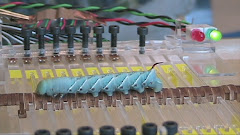Working in reverse, I started to examine how inching caterpillars may revert to crawling gait. Behaviorally it's quite feasible and we've observed some tiny step crawling when inchworms adjust their bodies on the foliage. My discovery of the day was that by constraining the uplifting body bend, I can actually induce crawling in many caterpillars that inch as their default gait. What I did was a very simple behavioral experiment: take a sheet of heavy duty plastic bag and lay it on top of a inching caterpillar on a flat surface. The result was quite stunning: the weight of the plastic prevent body upward bulking, so the inchworms start the stereotypical anterior-grade crawling. The very second plastic sheet constraint is gone (when I remove the plastic sheet or when they simply crawl out from under the sheet) they start inching again. This transition can happen at any phase of a gait cycle and so reversible that I can't imaging any other gait transition mechanism other than a biomechanical one. The implication is quite mind-bogging: inching gaits came naturally when mid-abdominal segments are not locked down to the substrate.
 6/8
6/8I went back to the memorial behind the casona today for the sunset. Actually I went with my friend Ian. The casona is a big historic farm house that has been converted to a little museum to document the development of ACG. The memorial was built for many worriers and political leaders who defended Costa Rica against an ambitious Nicaragua war-lord in 80's. This memorial is about two stories high at the top of a hill, overlooking the entire Santa Rosa sector and the two main volcanoes on the other side of the intercontinental highway. We walked up there briskly right after dinner and caught glimpse of sunset. Before it became pitch-dark, I looked around and wonder where the scorpion I met earlier went, and whether it also lingered around at sunset.
 6/9
6/9My Costa Rica stay is drawing to an end, but I feel that everything has just become part of my life... three meals of rice and beans everyday, new trails everywhere, mosquito swarms at certain spots, incomprehensible language that sounds very familiar, WiFi domain guided by the trees, checking e-mail late at night in pitch-dark with some frogs as companies. The list goes on and on, making my experience quite unforgettable.
 Today I decided to stop looking for caterpillars, otherwise I can't really wrap up the study. I went back to the caterpillar barn to examine all the caterpillars I've been working with and start to let them lose. If there is a video that is so amusing and that I can release freely, it is this video that I captured today of two noctuidae inching along a jar cover. Why is it funny? Well, I love the way they negotiate with each other. This circular walk lasted for about 6min until I got tired of filming. Apparently, you don't need very fancy enclosure to keep inching caterpillars. They would happily stay on a nice upright track even if it has a periodic boundary -- never ending. Isn't that what we call "inertia"?
Today I decided to stop looking for caterpillars, otherwise I can't really wrap up the study. I went back to the caterpillar barn to examine all the caterpillars I've been working with and start to let them lose. If there is a video that is so amusing and that I can release freely, it is this video that I captured today of two noctuidae inching along a jar cover. Why is it funny? Well, I love the way they negotiate with each other. This circular walk lasted for about 6min until I got tired of filming. Apparently, you don't need very fancy enclosure to keep inching caterpillars. They would happily stay on a nice upright track even if it has a periodic boundary -- never ending. Isn't that what we call "inertia"?








.jpg)